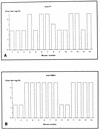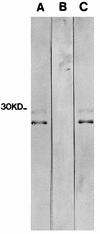Protective immune response to foot-and-mouth disease virus with VP1 expressed in transgenic plants
- PMID: 9445079
- PMCID: PMC124657
- DOI: 10.1128/JVI.72.2.1688-1690.1998
Protective immune response to foot-and-mouth disease virus with VP1 expressed in transgenic plants
Abstract
It has been reported recently that genes encoding antigens of bacterial and viral pathogens can be expressed in plants in a form in which they retain native immunogenic properties. The structural protein VP1 of foot-and-mouth disease virus (FMDV), which has frequently been shown to contain critical epitopes, has been expressed in different vectors and shown to induce virus-neutralizing antibodies and protection in experimental and natural hosts. Here we report the production of transformed plants (Arabidopsis thaliana) expressing VP1. Mice immunized with leaf plant extracts elicited specific antibody responses to synthetic peptides representing amino acid residues 135 to 160 of VP1, to VP1 itself, and to intact FMDV particles. Additionally, all of the immunized mice were protected against challenge with virulent FMDV. To our knowledge, this is the first study showing protection against a viral disease by immunization with an antigen expressed in a transgenic plant.
Figures




Similar articles
-
Induction of a virus-specific antibody response to foot and mouth disease virus using the structural protein VP1 expressed in transgenic potato plants.Viral Immunol. 2001;14(1):49-57. doi: 10.1089/08828240151061383. Viral Immunol. 2001. PMID: 11270596
-
Induction of a protective antibody response to foot and mouth disease virus in mice following oral or parenteral immunization with alfalfa transgenic plants expressing the viral structural protein VP1.Virology. 1999 Mar 15;255(2):347-53. doi: 10.1006/viro.1998.9590. Virology. 1999. PMID: 10069960
-
Protection of mice against challenge with foot and mouth disease virus (FMDV) by immunization with foliar extracts from plants infected with recombinant tobacco mosaic virus expressing the FMDV structural protein VP1.Virology. 1999 Nov 10;264(1):85-91. doi: 10.1006/viro.1999.9923. Virology. 1999. PMID: 10544132
-
Strategy for producing new foot-and-mouth disease vaccines that display complex epitopes.J Biotechnol. 1996 Jan 26;44(1-3):83-9. doi: 10.1016/0168-1656(95)00090-9. J Biotechnol. 1996. PMID: 8717390 Review.
-
Progress and perspectives in the development of a foot-and-mouth disease vaccine by recombinant DNA technology.Prog Vet Microbiol Immunol. 1987;3:59-72. Prog Vet Microbiol Immunol. 1987. PMID: 2483918 Review. No abstract available.
Cited by
-
Seroprevalence and risk factors for foot-and-mouth disease in cattle in Baghlan Province, Afghanistan.Vet Med Sci. 2021 Jul;7(4):1263-1275. doi: 10.1002/vms3.477. Epub 2021 Mar 23. Vet Med Sci. 2021. PMID: 33755343 Free PMC article.
-
Construction and immune response characterization of a recombinant pseudorabies virus co-expressing capsid precursor protein (P1) and a multiepitope peptide of foot-and-mouth disease virus in swine.Virus Genes. 2008 Apr;36(2):393-400. doi: 10.1007/s11262-008-0204-6. Epub 2008 Feb 2. Virus Genes. 2008. PMID: 18246420
-
Knowledge, Attitude and Practices Towards Foot and Mouth Disease Among Farmers and Veterinary Practitioners in Selected Border Regions of Pakistan Adjoining to Afghanistan.Vet Med Sci. 2025 Jul;11(4):e70215. doi: 10.1002/vms3.70215. Vet Med Sci. 2025. PMID: 40622088 Free PMC article.
-
High expression of foot-and-mouth disease virus structural protein VP1 in tobacco chloroplasts.Plant Cell Rep. 2006 Apr;25(4):329-33. doi: 10.1007/s00299-005-0074-5. Epub 2005 Dec 1. Plant Cell Rep. 2006. PMID: 16320056
-
Expression of immunogenic S1 glycoprotein of infectious bronchitis virus in transgenic potatoes.J Virol. 2003 Aug;77(16):9090-3. doi: 10.1128/jvi.77.16.9090-9093.2003. J Virol. 2003. PMID: 12885926 Free PMC article.
References
-
- Baulcombe D C, Saunders G R, Bevan M W, Mayo M A, Harrison B D. Expression of biologically active viral satelite RNA from nuclear genome of transformed plants. Nature. 1986;321:446–449.
-
- Bechtold N, Ellis J, Pelletier G. Agrobacterium mediated gene transfer by infiltration of adult Arabidpsis thaliana plants. CR Acad Sci Paris Sciences de la vie. 1993;316:1194–1199.
-
- Berinstein A, Piatti P, Gaggino O P, Schudel A A, Sadir A M. Enhancement of the immune response elicited with foot-and-mouth disease virus vaccines by an extract of the Mycobacterium sp. wall. Vaccine. 1991;9:883–888. - PubMed
-
- Brown F. Vaccination against foot and mouth disease virus. Vaccine. 1992;10:1022–1026. - PubMed
-
- Cottral G. Committee on Foreing Animal Diseases (ed.), Foreing Animal Disease. 3rd ed. Richmond, Va: United States Animal Health Association; 1975. Foot and mouth disease virus.
Publication types
MeSH terms
Substances
LinkOut - more resources
Full Text Sources
Other Literature Sources

